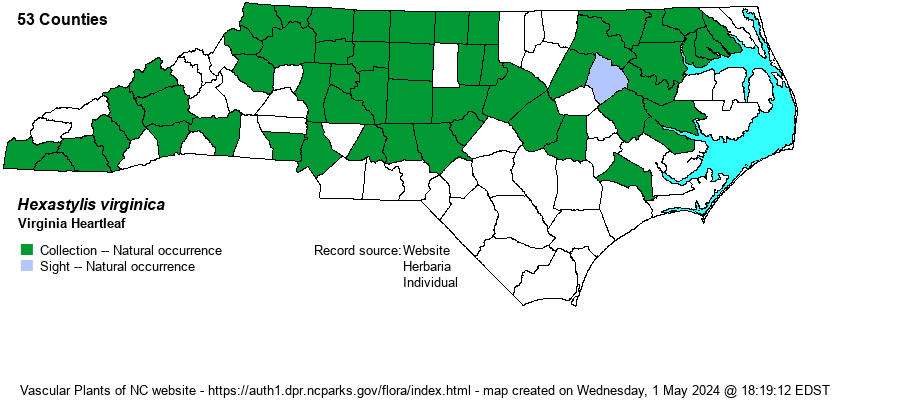| Author | (L.) Small | |
| Distribution | Very unsettled, and the number and range of specimens at the University of North Carolina herbarium (NCU) is quite small, with counties limited to: Caswell, Chowan, Davie, Gaston, Gates, Guilford, Hertford, Iredell, Johnston, Nash, Orange, Pitt, Rockingham, Stokes, Surry, and Watauga. Most of these counties lie in the northern half of the state, and except for Gaston and Iredell, most are limited to within about 30-50 miles of the VA border. Thus, the editors are concerned that most of the specimens in SERNEC are incorrectly identified, or at least need additional confirmation. The editors are not going to delete the other counties with SERNEC specimens from the map, but the message seems to be clear -- this is not as numerous a species in NC as the range map may suggest. For now, the range in the state covers the northern half of the Coastal Plain south to about Pitt and Johnston counties, the northern and central Piedmont (south to Iredell and rarely Gaston counties), and only the northern part of the Mountains. Thus, it is believed that the species does not occur at all in most of the NC Mountains, nor most of the southern Piedmont, as Weakley (2022) shows no records at all for SC, and it likely is not present in GA or southeastern TN either (as Weakley [2022] says only in northeastern TN).
According to Weakley (2022), it ranges north to WV, and ranges south to southern NC, and west to eastern KY and northeastern TN. It is found in nearly all counties in VA and most of WV, and thus is clearly a more northern Hexastylis species, with NC at the southern end of the range. | |
| Abundance | The fact that the NCNHP has not even given this species a State Rank is troubling, but it does indicate the puzzling nature of what this species truly entails. The website editors are assigning a shaky S4? for now, until this entity is better clarified, as the relatively few number of NCU specimens compared with the large number at other herbaria does give pause. How many of these other specimens have been checked for H. sorriei, H. minor, or some other species? It clearly occurs in the northern counties, where it is perhaps fairly common at least locally within about 50 miles of VA. Farther south, it is seemingly rare to uncommon, and south of Watauga County in the Mountains and most of the southern Piedmont the abundance and status is unsettled. | |
| Habitat | This species has such broad habitat requirements one must wonder if it perhaps consists of more than one species. It is the primary mottle-leaved Hexastylis present in the northern Coastal Plain, where it is usually found in the drier portions of forested floodplains, along stream banks, and other acidic and shaded habitats that are not in wetlands. However, farther west, into the Piedmont and northern mountains, it can be found in a variety of uplands, from hilly forested terrain to wooded stream banks. It usually is found in less xeric and less rocky sites than H. minor, and it tends to be found in flatter or more gently sloping ground than other mottled-leaved species. At all sites, the soil is acidic and not rich. |
| Phenology | Blooms from April to June, later than that of H. minor (which blooms mainly in February and March); fruits soon after flowering. | |
| Identification | This is a typical looking Hexastylis, with the several rounded leaves that are evergreen, shiny, and almost always variegated with white or light green along the veins. The leaves are about 2.5 inches across and long, with a cordate base. The several brown flowers, growing on the ground at the leaf bases, are fleshy like the others in the genus. However, they are rather small, with the cup being only about 1/2-inch high, with three rather short calyx lobes that are erect or slightly ascending, but usually not widely spreading as in H. minor. The primary identification character is the quite short calyx lobes, generally just 2-4 mm (about 1/8-inch) long, and the fact that they usually remain erect; other similar species in the range, such as H. heterophylla, H. naniflora, H. minor, and H. sorriei, have longer calyx lobes (mainly 1/4-inch long or longer) that also are widely spreading. This species is best found close to VA in the northern Coastal Plain counties, where there might not be any other identification contenders, and where it is not overly scarce -- as this is primarily a WV and VA species. | |
| Taxonomic Comments | Although this species has also been a good one in name, over time some other taxa have been subsumed into it, or have been pulled from it as "good" species. H. memmingeri is considered a good species by some authors but included within H. virginica by others, including Weakley (2018). Many individuals seen in the NC Piedmont seem to have characters of both H. minor and H. virginica, and keying them out does not work as well as expected. This treatment on the website is not likely the "final word"!
| |
| Other Common Name(s) | None | |
| State Rank | [S4?] | |
| Global Rank | G4 | |
| State Status | | |
| US Status | | |
| USACE-agcp | UPL link |
| USACE-emp | FACU link |

